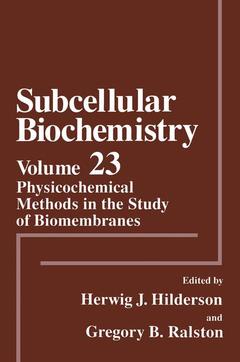Physicochemical Methods in the Study of Biomembranes, Softcover reprint of the original 1st ed. 1994 Subcellular Biochemistry Series, Vol. 23
Langue : Anglais
Coordonnateurs : Hilderson Herwig J., Ralston Gregory B.

In mammalian cells many physiological processes rely on the dynamics of the organization of lipids and proteins in biological membranes. The topics in this volume deal with physicochemical methods in the study of biomembranes. Some of them have a long and respectable history in the study of soluble proteins and have only recently been applied to the study of membranes. Some have tradi tionally been applied to studies of model systems of lipids of well-defined com position, as well as to intact membranes. Other methods, by their very nature, apply to organized bilayers comprised of both protein and lipid. Van Meer and van Genderen provide us with an introduction to the field (Chapter I). From their personal perspective regarding the distribution, trans port, and sorting of membrane lipids, they formulate a number of biologically relevant questions and show that the physicochemical methods described in this book may contribute in great measure to solving these issues. The methods of analytical ultracentrifugation have served faithfully for 60 years in the study of water-soluble proteins. The use of detergent extraction of membrane proteins, and the manipulation of density with H20/D20 mixtures, has extended this technique to the study of proteins, and in particular their interactions, from biological membranes. As described by Morris and Ralston in Chapter 2, this technique can be used to determine a number of important properties of proteins.
1 Intracellular Lipid Distribution, Transport, and Sorting: A Cell Biologist’s Need for Physicochemical Information.- 1. Introduction.- 2. Intracellular Lipid Topology: Some Problems.- 3. How Do Lipids Get Where They Are?.- 4. Final Remarks.- 5. References.- 2 Biophysical Characterization of Membrane and Cytoskeletal Proteins by Sedimentation Analysis.- 1. Introduction.- 2. Basic Concepts.- 3. Sample Preparation.- 4. Instrumentation.- 5. Sedimentation Velocity.- 6. Diffusion.- 7. Sedimentation Equilibrium.- 8. References.- 3 Monomolecular Layers in the Study of Biomembranes.- 1. Introduction.- 2. Experimental Techniques for the Study of Monomolecular Films.- 3. Examples of the Use of Monomolecular Layers.- 4. Perspective.- 5. References.- 4 Differential Scanning and Dynamic Calorimetric Studies of Cooperative Phase Transitions in Phospholipid Bilayer Membranes.- 1. Introduction.- 2. The Gel—Liquid-Crystalline Transition in Biological Membranes.- 3. Equilibrium Properties of Membrane Phase Transitions.- 4. Dynamic Properties of Membrane Phase Transition.- 5. Calorimetric Studies of Lipid—Protein Interactions.- 6. Concluding Remarks.- 7. References.- 5 Ektacytometry of Red Cells.- 1. History.- 2. Instrumentation.- 3. Factors Determining Erythrocyte Deformability.- 4. Membrane Properties.- 5. Ektacytometric Assays.- 6. Use of the Ektacytometer for Detection and Analysis of Membrane Defects.- 7. Transport Studies.- 8. Experimental Alteration of Membrane Mechanical Properties.- 9. Stability and Rigidity.- 10. Relationship to Other Techniques.- 11. Relationship to Blood Physiology.- 12. Molecular Basis for Membrane Mechanical Properties.- 13. References.- 6 Spin-Label ESR Study of Molecular Dynamics of Lipid/Protein Association in Membranes.- 1. Introduction.- 2.Thermodynamic Model of Lipid/Protein Association.- 3. Electrostatic Origin of Lipid Selectivity.- 4. Line Shape Effects of Solvation-to-Fluid Exchange.- 5. Slowly Exchanging Solvation Lipids.- 6. Novel Evidence for the Two-Site Exchange Model.- 7. Conclusions.- 8. References.- 7 NMR Methods for Measuring Membrane Transport.- 1. Introduction.- 2. General Concepts of NMR Relevant to Transport Analysis.- 3. Causes of Transmembrane Chemical Shift Differences.- 4. NMR Studies of Slow Membrane Transport Processes.- 5. NMR Studies of Fast Membrane Transport Processes.- 6. Compartmental Discrimination Using Diffusion Rates.- 7. Concluding Remarks.- 8. References.- 8 Determination of Soluble and Membrane Protein Structure by Fourier Transform Infrared Spectroscopy: I. Assignments and Model Compounds.- 1. Introduction.- 2. Band Assignments.- 3. Secondary Structures of Peptide Model Compounds.- 4. Dipole Orientation.- 5. Extinction Coefficients.- 6. References.- 9 Determination of Soluble and Membrane Protein Structure by Fourier Transform Infrared Spectroscopy: II. Experimental Aspects, Side Chain Structure, and H/D Exchange.- 1. Introduction.- 2. Experimental Aspects.- 3. Amino Acid Side Chain Structure.- 4. Hydrogen/Deuterium Exchange.- 5. Lipid/Protein Ratios.- 6. References.- 10 Determination of Soluble and Membrane Protein Structure by Fourier Transform Infrared Spectroscopy: III. Secondary Structures.- 1. Introduction.- 2. Determination of Protein Secondary Structures by Fourier Self-Deconvolution Techniques.- 3. Determination of Protein Secondary Structures by Pattern Recognition Methods.- 4. Derivative Spectroscopy.- 5. Isotopic Labeling of Proteins.- 6. References.- 11 X-Ray Diffraction on Biomembranes with Emphasis on Lipid Moiety.- 1. Introduction.- 2. Crystal Structure of Membrane Lipids.- 3. Diffraction from Partly Ordered or Disordered Lipid Systems.- 4. X-Ray Diffraction with Synchrotron Radiation.- 5. Diffraction from Thin Lipid Films: Monolayers and Langmuir—Blodgett Films.- 6. Radiation Damage.- 7. References.
This volume surveys a wide range of the latest biophysical and spectroscopic methods, offering a well-integrated and interdisciplinary view of biological membranes. Researchers will appreciate the extensive study on how secondary structures of proteins can be derived from Fourier transform infrared spectrocopy.
Date de parution : 10-2012
Ouvrage de 509 p.
15.2x22.9 cm
Thèmes de Physicochemical Methods in the Study of Biomembranes :
Mots-clés :
Biomembran; Lipid; membrane; membrane transport; protein; proteins; spectroscopy
© 2024 LAVOISIER S.A.S.



